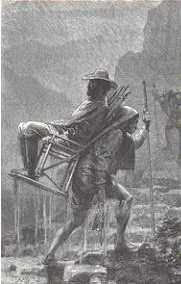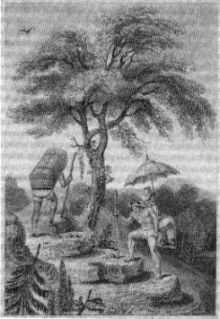Sillero


The silleros, cargueros or silleteros (also called saddle-men) were the porters used by colonial officials to carry them and their belongings across the Quindio pass in the Colombian Andes.[2][3] Silleros often carried between 100 and 200 pounds (50 and 90 kg) of weight crossing the pass which was considered the most difficult of the northern Andean passes. Besides their baggage, silleros even carried the travelers, such as colonial officials or explorers, in a wickerwork chair mounted on their backs while crossing the mountains.[4]
The practice was described by Alexander von Humboldt who crossed the Quindio in 1801 – he refused to be carried and preferred making the hike on foot.[5][6] Humboldt noted that porters were generally mestizo or whites, while others have stated that they were most often Indigenous – and the contemporary descriptions often referred to the mode of transportation as, "a lomo de indio" (on Indian back).[7]
Another traveler who described the practice was Captain Charles Cochrane of the British Navy who criticized the infrastructure of Colombia and as Humboldt did, refused to mount silleros. He wrote that "I have been told that the Spaniards and the natives mount these chairmen with as much sang froid as if they were getting on the back of mules, and some brutal wretches have not hesitated to spur the flanks of these poor unfortunate men when they fancied they were not going fast enough".[8]
According to nineteenth-century anecdotes, sometimes, when hired by particularly demanding or demeaning masters, the Indian porters would tire from the heavy burdens put upon them and eventually, would throw their riders into the abyss and escape into the forest.[9] Cochrane also noted that the 300 silleros of Ibagué rarely lived past the age of 40 and that a leading cause of death was the bursting of a blood vessel or pulmonary problems.[10]
In his work "Shamanism, Colonialism, and the Wild Man", anthropologist Michael Taussig describes the practice of using silleros to cross the Andes as part of the colonial tendency to see and treat the indigenous people as subhuman wild creatures.[11]
Silleteros in Colombia
In parts of Andean Colombia, such as Antioquia, the silletero still exists and is considered an important part of the cultural heritage of the area, although now, they only carry goods, not passengers.[12]

There is an annual flower festival called the Feria de las Flores in Medellín in the summer. One of the main events of the festival is a parade of silleteros who carry silletas filled with artistically-designed floral arrangements.
References
- ↑ The Alexander von Humboldt collection at the University of Potsdam
- ↑ http://www.banrepcultural.org/book/export/html/71188
- ↑ Acevedo Tarazona, A. 2005. El camino Quindío en el centro occidente de Colombia: la ruta, la retórica del paisaje y los proyectos de poblamiento. Estudios Humanísticos no. 4 pp. 9-36
- ↑ Taussig 1986:298
- ↑ Alexander von Humboldt David Yudilevich Levy (ed.). 2006. Mi Viaje Por El Camino Del Inca. Editorial Universitaria
- ↑ Jason Wilson. 2009. The Andes. p. 223 Oxford University Press
- ↑ «...y por caminos y cuestas que suben los hombres abajados y por bejucos y por tales partes que temen ser despeñados suben ellos con cargas y fardos de a tres arrobas y más y algunos en unas silletas de cortezas de árboles llevan a cuestas un hombre o una mujer (...) y si hubiese alguna paga irían con descanso a sus casas, mas todo lo que ganan y les dan a los tristes, lo llevan los encomenderos....» A hombro de indio. (From: Aperçu General sur la Colombie et recits de voyages en Amérique. C.P. Ettienne, Genóve, Imprimerie Maurice Richter 1887. Biblioteca particular de Pilar Moreno de Ángel)at banrepcultural.org
- ↑ Taussig 1986:298
- ↑ C. Taylor, 1825. p. 39-40. The Eclectic Review, Volume 24. Samuel Greatheed, Daniel Parken, Theophilus Williams, Thomas Price, Josiah Conder, William Hendry Stowell, Jonathan Edwards Ryland, Edwin Paxton Hood (eds.)The Eclectic Review vol 24
- ↑ Taussig 1986:298
- ↑ Taussig, Michael. 1986. Chapter 18 "On the Indian's Back" in Shamanism, Colonialism, and the Wild Man. University of Chicago Press.
- ↑ Silleteros in Antioquia digital
- ↑ John Potter Hamilton at banrepcultural.org